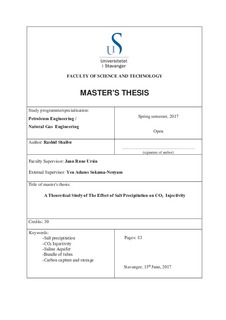| dc.contributor.advisor | Ursin, Jann Rune | |
| dc.contributor.author | Shaibu, Rashid | |
| dc.date.accessioned | 2017-10-26T13:53:24Z | |
| dc.date.available | 2017-10-26T13:53:24Z | |
| dc.date.issued | 2017-06 | |
| dc.identifier.uri | http://hdl.handle.net/11250/2462425 | |
| dc.description | Master's thesis in Petroleum engineering | nb_NO |
| dc.description.abstract | Global concern on climate change due to the greenhouse effect has led to various efforts to tackle anthropogenic Green House Gas (GHG) emissions. Of the various GHGs, CO2 poses the greatest threat to the fight against climate change. Carbon Capture and Storage (CCS) especially in saline aquifers is recognized as a key solution to reducing atmospheric CO2. Injectivity problems may however arise due to brine vaporization and consequently salt precipitation when dry super critical CO2 is injected into saline aquifers. Several experimental and numerical studies have reported various levels of injectivity impairment attributed to salt precipitation but the mechanism of injectivity reduction is still uncertain. This work focused on the study of the basic mechanisms of salt distribution in the porous medium during precipitation and the consequences on CO2 injectivity. A theoretical model to quantify injectivity loss due to salt precipitation was developed using a bundle of capillary tubes model. The model can reproduce some experimental results of drying of brine-saturated sandstone cores by supercritical CO2 injection in the laboratory. A sensitivity of the parameters affecting injectivity show that; (1) salt precipitation occurs in the dry-out zone where most of the irreducible water in the trapped brine have evaporated, (2) increasing brine salinity has adverse effect on injectivity, (3) salt precipitation affects permeability more than porosity and (4) in rocks with high initial permeability, salt precipitation is minimal. These findings are important for a successful CCS project since CO2 injectivity controls essential aspects of storage which are the rate, the quantity and length of time for CO2 injection in a formation. | nb_NO |
| dc.language.iso | eng | nb_NO |
| dc.publisher | University of Stavanger, Norway | nb_NO |
| dc.relation.ispartofseries | Masteroppgave/UIS-TN-IPT/2017; | |
| dc.subject | petroleumsteknologi | nb_NO |
| dc.subject | petroleum engineering | nb_NO |
| dc.subject | salt precipitation | nb_NO |
| dc.subject | carbon capture and storage | nb_NO |
| dc.subject | bundle of tubes | nb_NO |
| dc.subject | saline aquifer | nb_NO |
| dc.subject | CO2 injectivity | nb_NO |
| dc.title | A Theoretical Study of the Effect of Salt Precipitation on CO2 Injectivity | nb_NO |
| dc.type | Master thesis | nb_NO |
| dc.subject.nsi | VDP::Technology: 500::Rock and petroleum disciplines: 510::Petroleum engineering: 512 | nb_NO |
